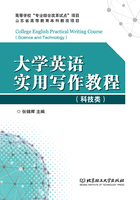
第三节 形容词的用法
形容词有其结构特点和句法特点。从构词上讲,以-able, -al, -ful,-ic, -ish, -less, -ous, -y等后缀结尾的词,一般是形容词,如:sympathetic(同情的), specific(明确的), cheerful(快乐), typical(典型的), intellectual(智力的), imaginary(想象的), gradual(逐渐的), sensible(明智的), available(可利用的)等。从句法功能上讲,大多数形容词都可以作定语和表语,可用副词来修饰,有比较级和最高级形式。如:
The park is very beautiful.(作表语)
There is a beautiful park.(作定语)
一、形容词的一般用法
(一)用作定语
形容词可以用来修饰、限定、说明名词的品质或特征。
We can infer from the passage that strong family and community ties can contribute to stable marriages.(CET-4, 2013.06)
The result of constant muscle tension and stiffness of joints, many of them are avoidable, and simple flexibility training can prevent these by making muscles stronger and keeping joints lubricated.(CET-4, 2013.06)
By 1973, domestic US sources of oil were peaking, and the nation was importing more of its oil, depending on a constant flow from abroad to keep cars on the road and machines running.(CET-6, 2013.06)
However, many complain that their school libraries do not have enough upto-date interesting books and magazines(CET-4, 2013.06)
Twitter's huge success is rooted in the simple but profound insight that in a medium with infinite space for self-expression, the most interesting thing we can do is restrict ourselves to 140 characters.(CET-6, 2013.12)
如果出现不同层次的形容词做前置修饰语,词序是:限定词→大小、形状、新旧→颜色→国别,来源,材料→用途,目的→名词类别→名词中心词。如:
a large black German military jeep.
(二)用作表语
形容词作表语用来说明主语的性质、特征和状态,常位于系动词(be, become, appear, seem, look, sound, feel, get, smell等词)之后。
Almost every child, on the first day he sets foot in a school building, is smarter, more curious, less afraid of what he doesn't know, better at finding and figuring things out, more confident, resourceful, persistent and independent than he will ever be again in his schooling—or, unless he is very unusual and very lucky, for the rest of his life.(CET-4, 2010.06)
The supervisor of the laboratory is beginning to get headaches and dizzy spells because she says it's dangerous to breathe some of the chemical smoke there.(CET-4, 2011.06)
They are interesting for the fact that they are very plain and undecorated for the time, with only one plain central panel at the back and no armrests.(CET-6, 2013.12)
(三)用作宾语补足语
They need to keep teams small and focused: giving in to pressure to be more inclusive is a guarantee of dysfunction.
She speculated that professors might try even harder to make classes interesting if they were to compete with the devices.(CET-6, 2013.06)
注:有些形容词只能作表语,不能作定语,这些形容词包括ill, asleep, awake, alone, alive, well, worth, glad, unable, afraid等。例如:
Don't be afraid.(正)
Mr Li is an afraid man.(误)
The old man was ill yesterday.(正)
This is an ill person.(误)
This place is worth visiting.(正)
That is a worth book.(误)
有些形容词只能作定语,不能作表语,这些形容词包括little, live等。例如:
This is a little house.(正)
The house is little.(误)
Do you want live fish or dead one?(正)
The old monkey is still live.(误)
二、形容词比较级与最高级
大多数形容词有三种形式:原级、比较级和最高级,以表示形容词说明的性质在程度上的不同。形容词的比较级和最高级形式是在形容词的原级形式的基础上变化的,分为规则变化和不规则变化。
(一)变化规则
1.规则变化
(1)单音节形容词的比较级和最高级形式是在词尾加-er和-est构成。例如:
great(原级)
greater(比较级)
greatest(最高级)
small(原级)
smaller(比较级)
smallest(最高级)
(2)以-e结尾的单音节形容词的比较级和最高级在词尾加-r和-st构成。例如:
wide(原级)
wider(比较级)
widest(最高级)
(3)以-y结尾,但-y前是辅音字母的形容词的比较级和最高级是把-y去掉,加上-ier和-iest构成.
happy(原形)
happier(比较级)
happiest(最高级)
(4)以一个辅音字母结尾、其前面的元音字母发短元音的形容词的比较级和最高级要双写该辅音字母再加-er和-est。
big(原级)
bigger(比较级)
biggest(最高级)
(5)双音节和多音节形容词的比较级和最高级用more和most加在形容词前面来构成。
beautiful(原级)
more beautiful(比较级)
most beautiful(最高级)
important(原级)
more important(比较级)
most important(最高级)
2.常用的不规则变化

(二)形容词各等级的用法
1.原级(同级)
比较:as. . . as. . . ; not as(so). . . as. . .
We'll give you as much help as we can.
She isn't as(so)active in sports as before.
2.比较级
表示“A比B更……”,形容词比较级可用状语much, a little, even等修饰。
He made fewer mistakes than I did.
He is even richer than I.
3.最高级
形容词最高级前必须加the,后面加用“of. . . /in. . . ”短语表示比较范围。
It was the most/least interesting story I have ever listened.
He is the tallest in the class.